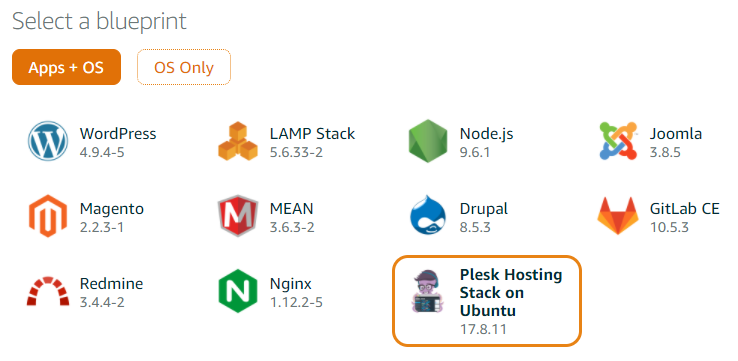Installing Plesk on Amazon Lightsail
Provided Product Configuration
The following Plesk configuration is available on Amazon Lightsail.
| Plesk | Components set |
|---|---|
| Plesk Hosting Stack on Ubuntu | Recommended set* (Fail2Ban, ModSecurity, Plesk Firewall, and **WordPress Toolkit are installed by default) |
Note: *The Recommended components set includes all components necessary for web hosting (including the web server, a mail server, a database server, and so on), plus the most popular and widely used features. For more information about Plesk Hosting Stack on Ubuntu, see the topic Plesk Web Admin SE.
Note: **WordPress Toolkit in Plesk Hosting Stack on Ubuntu provides only basic functionality. To use premium WordPress features, upgrade your Plesk license to Web Pro or Web Host Edition.
Installing Plesk on Amazon Lightsail
To install Plesk on Amazon Lightsail:
-
Sign in to an existing AWS account or create a new one.
Note: If you are trying to access Amazon Lightsail and you see 403 HTTP error, create an IAM policy to access Lightsail and attach it to a new or existing user.
-
Go to Lightsail and click Create instance.
-
Under “Instance location”, click Change Region and zone and select a region. If you plan to host small business websites, we recommend choosing the zone closest to their geographic location to decrease page load times for local visitors.
-
Under “Pick your instance image” > the “Apps + OS” tab, select Plesk Hosting Stack on Ubuntu.
-
(Optional) Click + Add launch script to add a shell script that will run on your instance the first time it launches.
-
(Optional) Lightsail creates a default key pair in each AWS Region where you have an instance. If you want to connect to your Plesk instance using an SSH client (for example, PuTTY), click Download to download the default private key.
If you do not want to use the default key pair, click Change SSH key pair to change it and do following:
- Click Create New + to create a new key pair.
- Click Upload New to upload a new key pair.
-
Choose your instance plan. Plesk Hosting Stack on Ubuntu is available starting with the 10-dollar per month Lightsail plan.
-
Under “Name your instance”, give your instance a recognizable name and specify the number of instances you want to deploy.
-
Click OK.
The instance is now being deployed. It is displayed on the “Resources” tab.
Note: Do not restart an instance or assign a static IP address to it, until the instance is fully deployed. The deployment will take a while. If you log in to the Plesk instance that is being deployed, you will see the maintenance screen. Once the deployment is finished the maintenance screen is removed and Plesk is ready for use.
-
If you want to use Plesk on Amazon Lightsail for web hosting, assign a static IP address to your instance, and then restart Plesk.
Accessing Plesk for the first time
To log in to Plesk for the first time, you need to generate a one-time login link. Go to the generated URL to log in to Plesk and set an administrator password. You will then be able to log in to Plesk using that password.
To access Plesk for the first time:
- Open the following ports in the Amazon Lightsail Firewall: TCP 8443, TCP 8447, UDP 53, TCP 53. For more information, refer to this topic.
- Access the instance command line using the Lightsail browser-based SSH client or a third-party SSH client (for example, PuTTY).
- Run the command:
sudo plesk login | grep -v internal:8
A one-time login link will be generated. Use it to access Plesk as an administrator.
When you access Plesk for the first time, you need to provide the following information:
- Full hostname
By default, Amazon Lightsail generates and assigns a hostname to the instance once you have started it. However, some spam filters (including the default Plesk greylisting) treat mail sent from servers with such hostnames as spam. We recommend using a registered domain name as the server hostname.
- Default IP address
The private IP address of the server is detected automatically. To avoid connectivity issues, do not register your instance’s public IP address in Plesk . Only the private IP address must be registered.
We also recommend configuring the server to keep the DNS records of subdomains in separate DNS zones. To do so, run the following command:
/usr/local/psa/bin/server_pref -u -subdomain-dns-zone own
- Administrator’s password
For detailed instructions on the Plesk post-install configuration, see Post-install Configuration on a Single Server.


